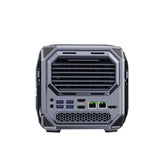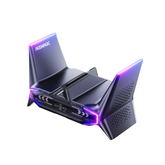NVMe Explained: Advantages and Applications of High-Performance Storage

In today's digital age, data is central to our lives and work, and the performance of storage technology directly affects system efficiency. Traditional mechanical hard drives (HDDs), while offering large capacity and low cost, are hindered by slow speeds and limited reliability due to their mechanical parts. Solid-state drives (SSDs) revolutionized storage by using flash memory chips, eliminating mechanical components and significantly boosting read/write speeds and system responsiveness. However, interfaces like SATA and SAS have become bottlenecks, limiting further performance enhancements of SSDs.
Enter NVMe (Non-Volatile Memory Express), a new-generation storage protocol designed specifically for high-speed flash media. By leveraging the PCIe bus to connect directly with the CPU, NVMe provides higher bandwidth and lower latency, unleashing the full potential of SSDs. NVMe offers a groundbreaking solution to storage performance bottlenecks and is propelling storage technology to new heights.
What Is NVMe?
Definition of NVMe
NVMe, short for Non-Volatile Memory Express, is a new communication protocol specifically designed for non-volatile storage media like flash memory and SSDs. NVMe aims to fully harness the potential of high-speed storage media by providing high throughput and low-latency access, meeting modern computing's demands for rapid data exchange.
NVMe Architecture and Working Principle
NVMe communicates directly with the CPU via the PCIe bus, bypassing the limitations of traditional storage controllers. It supports up to 64,000 parallel I/O queues, each capable of handling up to 64,000 commands. This multi-queue parallel processing allows data transmission to fully exploit multi-core processors, greatly enhancing transfer efficiency and system performance. The NVMe instruction set has also been simplified and optimized, further reducing command processing overhead.
Differences Between NVMe and Traditional Storage Protocols
Traditional storage protocols like SCSI and AHCI were initially designed for mechanical hard drives and support a limited number of command queues, which is insufficient for high-speed SSDs. In contrast, NVMe has significant advantages in latency, bandwidth, and concurrency. NVMe offers lower latency by reducing intermediate layers in data transmission; higher bandwidth by leveraging PCIe lanes for faster data transfer rates; and stronger concurrency, as its multi-queue mechanism enables more efficient parallel data processing. These enhancements allow NVMe to fully capitalize on SSD performance, providing robust support for high-performance computing and big data processing.
Advantages of NVMe
1. High-Speed Transfer Performance
NVMe dramatically boosts read and write speeds by using the PCIe bus directly for data transfer. Traditional SATA interfaces limit SSDs to about 600 MB/s, but NVMe achieves theoretical bandwidths of up to 4 GB/s with PCIe 3.0 x4 lanes and 8 GB/s with PCIe 4.0. This high-speed capability meets the demands for rapid data exchange and high throughput.
2. Low Latency and High Concurrency
Supporting up to 64,000 concurrent I/O queues, each with up to 64,000 commands, NVMe handles numerous I/O requests simultaneously, greatly reducing data access latency. In contrast, the AHCI protocol supports only one queue with 32 commands. NVMe's low-latency and high-concurrency features ensure efficient and stable performance even during large-scale concurrent tasks.
3. Enhanced System Performance
NVMe significantly improves overall system performance by accelerating data access and transfer, reducing application startup and load times. For storage-intensive applications like databases, virtualization, and real-time analytics, NVMe minimizes I/O bottlenecks, enhancing efficiency and responsiveness, thus boosting user experience and productivity.
4. Energy Efficiency and Thermal Management
Optimized for energy efficiency, NVMe processes data more quickly, reducing device operating time and lowering power consumption. Without mechanical moving parts, NVMe SSDs generate less heat, improving thermal efficiency. In data centers and large servers, this reduces energy consumption and operational costs while enhancing system stability and longevity.
Comparison of NVMe and Traditional Interfaces
NVMe vs. SATA
NVMe and SATA are the primary interface standards used by current solid-state drives (SSDs), but they differ significantly in bandwidth, speed, and protocol architecture. SATA (Serial ATA) was originally designed for mechanical hard drives. The third-generation SATA III has a maximum transfer rate of 6 Gbps, with actual bandwidth around 600 MB/s. This bandwidth limitation prevents SATA interfaces from fully leveraging the performance of high-speed SSDs, becoming a performance bottleneck. Additionally, SATA uses the AHCI protocol, which supports only a single command queue with limited command depth, making it difficult to meet the demands of modern high-concurrency data transfers.
In contrast, NVMe communicates directly with the CPU via the PCIe bus. A PCIe 3.0 x4 lane offers theoretical bandwidth up to 32 Gbps (about 4 GB/s), while PCIe 4.0 and PCIe 5.0 boost bandwidth to 64 Gbps and 128 Gbps, respectively. This high bandwidth significantly enhances the read and write speeds of NVMe SSDs, with sequential read speeds exceeding 3,500 MB/s—far surpassing the approximately 550 MB/s of SATA SSDs. Moreover, the NVMe protocol supports up to 64,000 parallel I/O queues, each capable of holding 64,000 commands, fully utilizing multi-core processors to reduce latency and improve concurrency performance. Overall, NVMe's advancements in bandwidth, speed, and protocol architecture make it the preferred choice for high-performance storage.
NVMe vs. SAS
The SAS (Serial Attached SCSI) interface is mainly used in enterprise-level storage, offering high reliability and data integrity. The SAS 3.0 standard provides a transfer rate of 12 Gbps, with actual bandwidth around 1.2 GB/s—an improvement over SATA but still lagging behind NVMe. NVMe achieves higher bandwidth and lower latency through PCIe lanes, and its sequential read/write speeds and I/O performance far exceed those of SAS SSDs.
In enterprise applications, SAS devices have been widely adopted due to their mature technology and stable performance, making them suitable for storage systems that require high reliability and availability. However, as NVMe technology matures and costs decline, more businesses are turning to NVMe SSDs to boost the performance of critical applications. For instance, in databases, high-performance computing, and virtualization environments, NVMe offers faster data access speeds and greater concurrent processing capabilities. While SAS still has advantages in certain specific scenarios, NVMe's superior performance and scalability position it as the future direction of enterprise storage development.
Types of NVMe Slots
M.2 Slots

The M.2 slot is the most common NVMe SSD interface today. Its compact design makes it widely used in laptop and desktop motherboards. M.2 slot sizes are indicated by numbers, commonly 2230, 2242, 2260, 2280, and 22110. In these numbers, the first two digits "22" represent a width of 22 millimeters, and the last two digits indicate the length—for example, "80" means 80 millimeters. So, an SSD with a 2280 specification is 22 mm wide and 80 mm long.
Additionally, M.2 slots use key notches to differentiate between interface types and supported protocols. Common keys include B Key, M Key, and B+M Key. NVMe SSDs typically use the M Key slot, while SATA SSDs might use B Key or B+M Key slots. When selecting an NVMe SSD, you need to ensure that your motherboard's M.2 slot supports the NVMe protocol and has the corresponding key to guarantee compatibility.
PCIe Slots

PCIe slots are another way to connect NVMe SSDs, primarily through PCIe expansion cards. If the motherboard lacks M.2 slots or you need to add more NVMe SSDs, you can use a PCIe adapter card to install NVMe SSDs into the motherboard's PCIe slots. PCIe slots come with different lane counts, such as x1, x4, x8, and x16. NVMe SSDs usually require at least a PCIe x4 slot to achieve optimal performance.
The number of PCIe lanes directly affects the performance of an NVMe SSD. A PCIe 3.0 x4 slot has a theoretical bandwidth of 32 Gbps (about 4 GB/s), while PCIe 4.0 x4 reaches 64 Gbps (about 8 GB/s). When connecting an NVMe SSD via a PCIe slot, you need to ensure that the slot's lane count and version meet the SSD's requirements; otherwise, performance may be limited or the device may not function properly.
Recommended Reading: What Is PCI Express (PCIe) and PCIe Slot? A Comprehensive Overview
U.2 Interface
The U.2 interface is used for connecting NVMe SSDs in enterprise-level applications. Unlike the M.2 interface, U.2 uses a 2.5-inch form factor, making it convenient for deployment in servers and storage arrays. The U.2 interface connects via the SFF-8639 standard and supports PCIe lanes for high-bandwidth, low-latency data transmission.
The main differences between the U.2 and M.2 interfaces are support for hot-swapping, better heat dissipation, and larger storage capacities. This makes U.2 SSDs ideal for enterprise environments that require high reliability and performance. Additionally, the U.2 interface can connect to the motherboard via cables, offering a more flexible installation method that simplifies maintenance and upgrades.
Frequently Asked Questions (FAQ)
What is the difference between NVMe and M.2?
While NVMe and M.2 often appear together, they refer to different concepts. NVMe (Non-Volatile Memory Express) is a high-performance storage protocol designed specifically for high-speed flash storage media. M.2, on the other hand, is a physical interface specification that can support various protocols, including NVMe and SATA. Therefore, not all M.2 slots support the NVMe protocol; you must verify whether your motherboard's M.2 slot is compatible with NVMe SSDs.
My motherboard has an M.2 slot. Does it necessarily support NVMe SSDs?
Not necessarily. Depending on the motherboard design, an M.2 slot may support only the SATA protocol, only the NVMe protocol, or both. To determine if your motherboard supports NVMe SSDs, it's recommended to:
- Consult the motherboard manual to check the supported protocols for the M.2 slot.
- Check the key notch type of the slot: NVMe SSDs typically use the M Key. If the slot has a B Key or a B+M Key, it may only support SATA SSDs.
What are the differences and relationships among NVMe, SATA, and PCIe interfaces?
- SATA Interface: A traditional interface for connecting storage devices, using the AHCI protocol with a bandwidth limit of 6 Gbps. It's suitable for HDDs and some SSDs.
- PCIe Interface: A high-speed serial computer expansion bus standard that offers higher bandwidth. NVMe SSDs typically connect via PCIe lanes, including M.2, U.2, and PCIe slot forms.
- NVMe Protocol: A storage protocol specifically designed for high-speed flash memory, leveraging PCIe's high bandwidth and low latency to overcome SATA interface performance bottlenecks.
In short, NVMe is a storage protocol, PCIe is a high-speed transmission bus standard, and SATA is a traditional interface and protocol standard. NVMe SSDs achieve high-speed data transfer through the PCIe interface, while SATA SSDs are limited by lower bandwidth.
What is the difference between NVMe and AHCI, and why is NVMe performance superior?
AHCI (Advanced Host Controller Interface) is an interface protocol designed for traditional mechanical hard drives and early SSDs, suitable for SATA interfaces. It supports a single command queue with limited command depth, restricting the performance of high-speed storage devices.
NVMe is a protocol tailor-made for high-speed flash storage media, offering several advantages:
- Multi-Queue Parallel Processing: Supports up to 64,000 concurrent I/O queues, each with 64,000 commands, significantly boosting concurrent processing capabilities.
- Low Latency: Simplified instruction sets and architecture that communicates directly with the CPU reduce data transmission latency.
- High Bandwidth: Utilizes the high bandwidth of the PCIe interface to achieve faster data transfer speeds than the SATA interface.
Therefore, NVMe can fully exploit the performance of SSDs, providing higher read/write speeds and lower latency, significantly outperforming SATA SSDs that use the AHCI protocol.
Is NVMe better than SSD?
NVMe (Non-Volatile Memory Express) is a high-performance storage protocol, while SSD (Solid State Drive) is a general term for solid-state drives. SSDs can use different interfaces and protocols, including SATA and NVMe. So, directly comparing NVMe and SSD isn't entirely accurate.
Compared to SATA SSDs, NVMe SSDs typically offer higher read/write speeds and lower latency. This is because NVMe SSDs use PCIe lanes, providing greater bandwidth and concurrency to fully leverage SSD performance advantages. Therefore, when comparing NVMe SSDs to SATA SSDs, NVMe SSDs usually perform better.
Related Article
DDR4 vs DDR5 RAM: Comprehensive Comparison Guide
DDR5 vs LPDDR5X: Speed, Gaming Performance & Which is Better
Single Channel vs Dual Channel RAM: Understanding the Impact on Performance







Leave a comment
Please note, comments need to be approved before they are published.